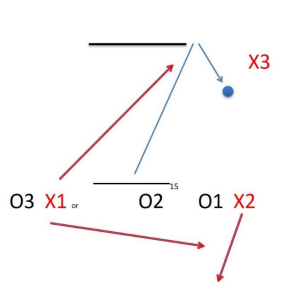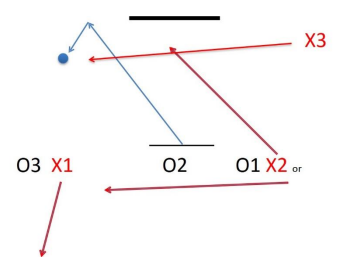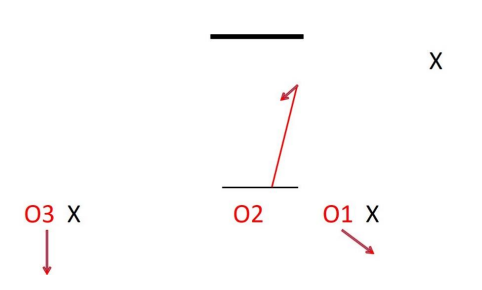As an open-goal penalty shooter, it is important to have a routine. No one (absolutely no one) can disrupt the player or his/her approach to the ball except that player and his/her horse. The player must take their time, relax, and strike the ball when ready. Make sure all players and their horses are ready to score a goal.
O3 This player should be positioned on the board-side of the opposing player lined up on left. O3’s responsibility is to be the first one to go back, ensuring there will not be an easy counterattack after a missed penalty shot. O3 needs to be the most pessimistic of the group and expect a miss. He/she must be prepared to be the first player back on defense and must cover the opposing teams offside. This prevents the other team from using the wall to their advantage.
O2 Ideally, O2 will make the penalty shot and the rest will take care of itself; this makes the teammates’ jobs much easier. If the shot gets missed (it happens to everyone!), it is O2’s responsibility to move quickly toward the defending player and wait for the rebound. It is important that O2 does not impede that player’s right to play the ball uncontested. Instead, O2 can come in with enough intensity to make the defending player acknowledge him/her and possibly trigger a mistake. O2 must move toward the defensive player, then stop and turn away to the defending goal, ready to react to whatever shot the defensive players make.
O1 This player should not be looking toward the goal, as there is nothing they can do with a rebound unless it comes back all the way past the 25. If the shot is wide, then O1 must make the 16 first move. By turning away from goal and making the first move, O1 will remove the offside of the opposing player, placing the team in position to receive any shot made up the field by the defense. O1 wants to put his/her horse’s nose to the boards with their horse’s shoulder in front of the opposing player to pin them there without pushing them into the boards. This keeps the opposing player from being able to go up the field for a pass.

In a penalty situation, it’s definitely not the time to take a break! When teammates are lined up and in position for the upcoming penalty, players can relax a bit when they are ready for whatever comes next.
Ball shot wide to left side of goalX3 Player is lined up on left-hand side of the goal. He/she must be prepared to react to the penalty shot and anticipate the rebound. Before the shot is made by the opposing team, X3 must know what their teammates would do if the ball misses to the left or right. Obviously, if it goes in, then everyone returns to the throw-in at center.
A successful defense here means the defending team gets the ball to the other side of midfield after a miss. Unless the ball is in a hole or too close to the boards, this player should not try to tap the ball when he/she first gets to it. The opposing team cannot hook the player, so X3 may use this to his/her advantage. If possible, X3 should release with a full swing on the first approach to the ball. It is extremely important not to hit a horse with the shot — this will create a rebound that cannot be controlled!
X2The player should not be afraid to face away from the goal. However, the rebound dictates X2’s play. If the shot is wide left and X3 approaches the ball with time and space to hit away, X2 must move up the field into an open space for a pass. It is very important that X2 does not force X3 to hit through horses when running for a pass. Ideally, X2 wants to get open to the right, but going across goal is dangerous. The real victory on a defensive penalty is to clear the danger and make a play downfield. X2 should be the most optimistic and should position themselves for a long pass.
12 X1Like X2, X1 shouldn’t be afraid to face away from the goal, but he/she must remember that the rebound determines X1’s play. In this case, the ball has gone wide to the left-hand side of the goal. If it is a long rebound (allowing time and space for X3 to hit away), then X1 must find open space between X2 and X3 so he/she is available for a pass.
Remember: It is important not to block a passing route for a teammate. If it is a short rebound on the miss (within 5 yards of the boards), then X1 should fall in behind X3 and provide cover for the goal, just in case a defensive play becomes difficult.
 Ball shot wide to right side of goal
Ball shot wide to right side of goal X3 Player is lined up on left-hand side of the goal. He/she must be prepared to react to the penalty shot and anticipate the rebound. Before the shot is made by the opposing team, X3 must know what their teammates will do if the ball missed to the left or right. Obviously, if it goes in, then everyone returns to the throw-in at center.
A successful defense here means the defending team gets the ball to the other side of midfield after a miss. Unless the ball is in a hole or too close to the boards, X3 should not try to tap the ball when he/she first gets to it. The opposing team cannot hook him/her, so X3 can use this to his/her advantage. If possible, X3 should release with a full swing on the first approach to the ball. Look to release the ball up the boards to X1, if possible. If that player is out of reach, however, then X3 must look to X2.
X2 Remember the rebound dictates X2’s play. If the rebound off the wall is long enough to give X3 time to approach comfortably and release with his/her first touch, then X2 should come across the field parallel to the goal to give X3 an option of a shorter pass to the right side. If the 13 ball stays too close to the wall, or the rebound is short and X3 doesn’t have a clear release, then X2 must come in behind to protect and help get the ball down the field.
X1If the rebound is long enough, X1 needs to hustle up the field. Ideally, X1 would get his/her mallet side open and present an option up the boards. At the very least, X1’s actions should pull a defending player with him/her, allowing X2 to come across the field into that space.

 In a penalty situation, it’s definitely not the time to take a break! When teammates are lined up and in position for the upcoming penalty, players can relax a bit when they are ready for whatever comes next.
In a penalty situation, it’s definitely not the time to take a break! When teammates are lined up and in position for the upcoming penalty, players can relax a bit when they are ready for whatever comes next.  Ball shot wide to right side of goal
Ball shot wide to right side of goal